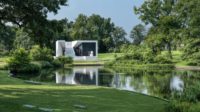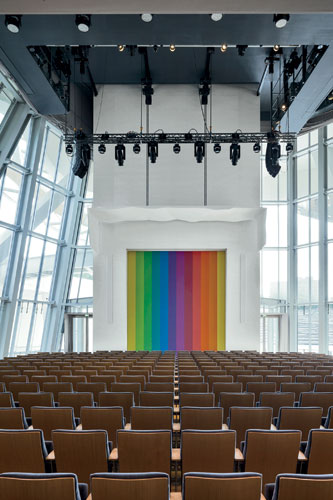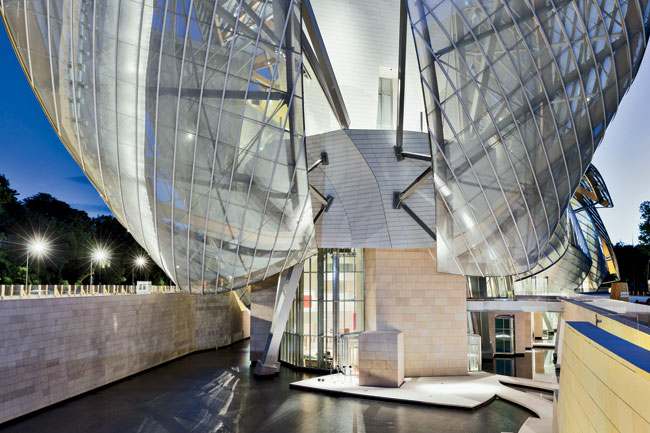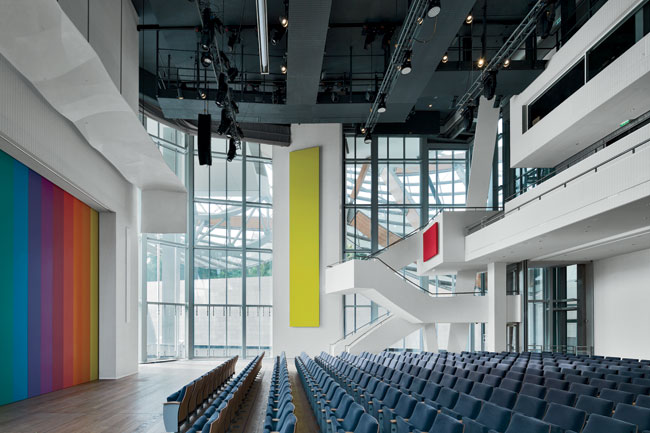Fondation Louis Vuitton Auditorium






Architects & Firms
Nagata Acoustics
Paris
The bucolic backdrop of the recently opened Fondation Louis Vuitton, set within Paris’s Bois de Boulogne park, inspired a garden building in the tradition of Joseph Paxton’s long-destroyed Crystal Palace. Like that famous structure, erected in London’s Hyde Park in 1851, Frank Gehry’s billowing new museum features vast expanses of glass.
Originally conceived as a venue for lectures and films, the room’s program morphed over the course of the project. The auditorium opens up to two adjacent galleries, setting the stage for fashion shows. (Luxury brand LVMH Mo't Hennessy-Louis Vuitton, headed by CEO Bernard Arnault, held its first Louis Vuitton show there during Paris Fashion Week in October.) “Later on, the ambition to perform chamber music and solo recitals in the room came along,” says Craig Webb, design partner at Gehry Partners. “At that point, it became much more challenging acoustically.”
Yasuhisa Toyota, of Nagata Acoustics’ Los Angeles office, the acoustician for all of Gehry’s performance spaces, including the Walt Disney Concert Hall in Los Angeles and Miami’s New World Symphony, was brought on board. Together they developed a scheme that would maintain the extensive glass and views from the 6,000-square-foot room, but also accommodate a flexible program and the superior acoustics required for recital spaces.
Nagata had experience working on other performance spaces that feature generous amounts of glass, including Arata Isozaki’s Nara Centennial Hall—a 1,700-seat shoeboxstyle concert hall completed in 1999. Its four walls are covered in glass panels, but the room has carpet, highly absorptive seat cushions, porous panels, and glass-wool batts to counteract the reflective nature of glass. Toyota took a different approach at the Fondation’s auditorium, where there are few soft surfaces. (Even the seats can fold down into the engineered-wood floor for a flat configuration.) “Although glass is challenging, not using it on the ceiling and most of the back wall helped,” says Toyota.
Imperceptible to visitors, a major intervention included adding a series of 11-foot-tall convex glass panels along the canted side walls to mitigate undesirable reflection back to the stage and into the auditorium. That second layer of curved glass on the large, flat windows scatters sound along non-uniform vectors, preventing it from being too sharp or bright in favor of a softer, more diffuse effect. The space—50 feet tall in some areas—also features an adjustable-height, cast-aluminum canopy with a resin-compound finish just above the stage. It provides a reflective surface, creating better onstage acoustics for varying performance types. “The main issue was to have enough mass to reflect the sound,” says Webb. “We needed a very dense material that allowed us to achieve the nearly 2-inch thickness and sculpted shape we were after.” The same material was used to create an acoustic reflector for the rear of the stage and for the proscenium aperture, which can be opened and closed.
Since a reverberation time that is optimal for a music program could be disastrous to the intelligibility of the spoken word—whether live or as part of the audio in film—the auditorium includes a series of curtains and black acoustical banners that come down out of the ceiling to completely cover all the glass. They convert the room, which during the day is typically flooded with natural light, into a dark, acoustically drier space that works well for film and amplified sound. While it is not certain how often the auditorium will be used for musical performances, Webb thinks it could be a frequent occurrence, especially since Arnault’s wife, Hélène Mercier, is a concert pianist. For the opening in October, jazz pianist Herbie Hancock performed in the space, and, according to Webb, “It sounded quite good.”
People |
Products |







